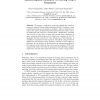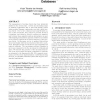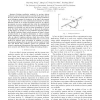12 search results - page 1 / 3 » Interpolating and Using Most Likely Trajectories in Moving-O... |
DEXA
2006
Springer
13 years 11 months ago
2006
Springer
In recent years, many emerging database applications deal with large sets of continuously moving data objects. Since no computer system can commit continuously occurring infinitesi...
IDA
2009
Springer
13 years 7 months ago
2009
Springer
We propose a method for trajectory classification based on trajectory voting in Moving Object Databases (MOD). Trajectory voting is performed based on local trajectory similarity. ...
DEBU
2010
13 years 9 months ago
2010
Databases supporting time dependent and continuously changing geometries, called moving objects databases, have been studied for about 15 years. The field has been flourishing and...
GIS
2005
ACM
14 years 10 months ago
2005
ACM
The management of moving objects has been intensively studied in the recent years. A wide and increasing range of database applications has to deal with spatial objects whose posi...
ICDE
2008
IEEE
14 years 10 months ago
2008
IEEE
Existing prediction methods in moving objects databases cannot forecast locations accurately if the query time is far away from the current time. Even for near future prediction, m...



